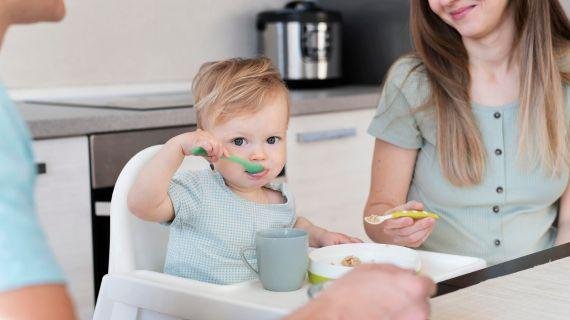-
Ροή Δημοσιεύσεων
- ΑΝΑΚΆΛΥΨΕ
-
Blogs
-
Ομάδες
The Ultimate Guide to Choosing Safe Baby Feeding Products

Choosing the right baby feeding products is essential for your child’s health, comfort, and development. With so many options available, it’s important to know what to look for when shopping for safe, reliable items. This guide will walk you through the most important factors to consider so you can feel confident about the products you bring home.
Prioritize Non-Toxic and BPA-Free Materials
When shopping for baby feeding products, always check the materials used. Plastic items should be BPA-free, phthalate-free, and PVC-free. Exposure to these chemicals has been linked to developmental issues and hormonal disruptions in infants.
Silicone is a popular alternative due to its safety, durability, and flexibility. Medical-grade or food-grade silicone products are especially safe and easy to clean. Glass bottles and stainless-steel items are also excellent choices for minimizing chemical exposure.
Look for Age-Appropriate Designs
Not all baby feeding products are suitable for every age. Infants, for instance, need soft nipple bottles, while older babies benefit from sippy cups or training spoons. Make sure to choose products labeled with the appropriate age range to ensure safety and ease of use.
For newborns, opt for slow-flow nipples and small bottles. As your child grows, you can transition to medium or fast-flow nipples and larger containers. Always follow the manufacturer’s recommendations.
Ensure Easy Cleaning and Sterilization
Cleanliness is crucial when it comes to baby feeding products. Choose items that are dishwasher-safe and can be boiled or sterilized without breaking down. Silicone, stainless steel, and high-quality plastics usually stand up well to regular cleaning.
Avoid products with too many small crevices where bacteria can hide. Bottles, utensils, and bowls with seamless construction are easier to clean and less likely to harbor harmful germs.
Choose Ergonomic and Baby-Friendly Shapes
Your baby will be learning to grasp, hold, and feed themselves, so the shape and size of the products matter. Baby feeding products should be designed to fit comfortably in small hands, with soft grips and rounded edges to prevent injury.
Spoons should be shallow and flexible to prevent gagging, and cups should have spill-proof lids to minimize messes. Non-slip bases for bowls and plates can help reduce tipping during self-feeding practice.
Opt for Trusted Brands and Certifications
It’s best to buy baby feeding products from reputable brands that prioritize safety and transparency. Look for certifications like:
-
FDA Approved
-
CPSC Compliant
-
BPA-Free Label
-
Medical or Food-Grade Materials
Brands that openly list their testing procedures and safety standards are generally more trustworthy. Read customer reviews, ask for recommendations, and check for product recalls before making a purchase.
Go for Multifunctional and Eco-Friendly Options
Choosing versatile baby feeding products can help you save money and reduce waste. Look for items that grow with your child, like bottles that convert into sippy cups or bowls that double as storage containers.
Eco-conscious parents may prefer products made from sustainable materials like bamboo, stainless steel, or silicone. Reusable feeding sets reduce plastic waste and are better for the environment long-term.
Consider Portability for On-the-Go Feeding
If you’re often out and about, portability is key. Compact baby feeding products with lids, clips, or travel cases make feeding on the go easier and cleaner. Collapsible bowls, stackable containers, and travel spoons are perfect for busy parents.
Make sure to carry a portable cleaning wipe or sterilizer bag, especially for trips longer than a few hours. Clean feeding tools reduce the risk of exposure to harmful bacteria and viruses.
Watch for Signs of Wear and Tear
Even the best baby feeding products need to be replaced over time. Watch for cracks, discoloration, or loose parts, as these can be breeding grounds for germs or pose choking hazards.
Nipples and pacifiers should be replaced every few weeks or sooner if damaged. Silicone items may last longer but should still be inspected regularly. Discard anything that looks compromised to ensure continued safety.
Create a Comfortable Feeding Environment
The feeding environment also plays a role in your baby’s experience. Choose a supportive high chair, a bib with good coverage, and calm surroundings to make feeding time enjoyable.
Consistency in your routine helps your child develop healthy eating habits. Combine high-quality baby feeding products with patience, encouragement, and attentiveness for the best outcomes.
Final Thoughts on Choosing Baby Feeding Products
With so many baby feeding products on the market, knowing what to look for can make all the difference. Focus on safety, ease of cleaning, proper sizing, and trusted brands when making your selection. Investing in high-quality, baby-safe materials like silicone or stainless steel ensures both peace of mind and long-term durability.
Always monitor how your baby interacts with new products and be ready to adjust as they grow and develop. Safe, functional feeding tools contribute to a smoother weaning journey and promote independent eating habits.
By being selective and informed, you give your child the safest, most supportive start possible.







